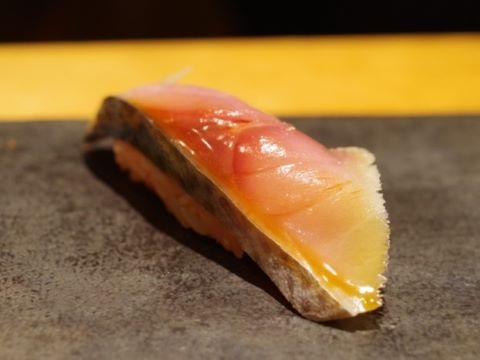
What is Blue mackerel (Gomasaba)?
Blue mackerel (Gomasaba) is distributed south of Wakasa Bay on the Sea of Japan side and south of the Boso Peninsula to the East China Sea on the Pacific side and in the northeast Pacific off Australia, New Zealand, Hawaii, and Mexico. And recently, they have been appearing in southern Hokkaido due to rising sea temperatures near Japan. They migrate northward along the coast of Japan in summer in pursuit of prey, and after spawning, migrate southward in autumn. The season is summer.
Compared to Chub mackerel (also called Pacific mackerel), the Blue mackerel has a fuzzy, irregular pattern on its back and scattered black-gray spots on its belly. These spots are goma (sesame seed)-like, hence the name Goma (Sesame) mackerel. Chub mackerel, which are tall and flat, are called Hira (Hira means flat)-saba, whereas Blue mackerel is called Maru (Maru means round)-saba because of their round body. The length of the fish is about 40 cm. Its scientific name is Scomber australasicus Cuvier, 1832.
Blue mackerel, also called Japanese mackerel, Pacific mackerel, slimy mackerel, or spotted chub mackerel.
What does Blue mackerel (Gomasaba) sushi taste like?

In Japan, most mackerel used for nigiri sushi is chub mackerel, and blue mackerel is rare. This is because Chub mackerel contains 16.8g of fat per 100g of edible part, while Blue mackerel contains only 5.1g of fat, so it is generally said to be inferior to Chub mackerel. On the other hand, Chub mackerel loses its flavor in summer, while Blue mackerel remains the same all year round.
But with the recent increase in catches, the reputation of Blue mackerel is changing. This is spurred by the appearance of blue mackerel that can be eaten raw. These include “Shimizu-saba (清水サバ)” from Kochi and “Kubiore-saba (首折れサバ)” from Kagoshima. Kubiore means “broken neck” and refers to a processing step after catching.
Mackerel is now also commonly served raw, but traditionally it is made with Sujime. The Sujime method, a preparation involving salt and vinegar, is used to preserve freshness, suppress odors and reduce the dominant inherent flavor of mackerel. The meat treated in this way is called Shime saba.
Some chefs sear the Sujime blue mackerel on straw to give it a savory aroma and soften the skin. Some chefs place Shiraita Kombu (a translucent thin slice of Kombu) on top of the topping to soften the acidity of the Sujime. We have a feeling that blue mackerel will be used in nigiri sushi from now on.
[sc_apply url=”https://sushiuniversity.jp/apply/”]
We hope this information will be helpful.

Revision date: October 15, 2025
Share this article